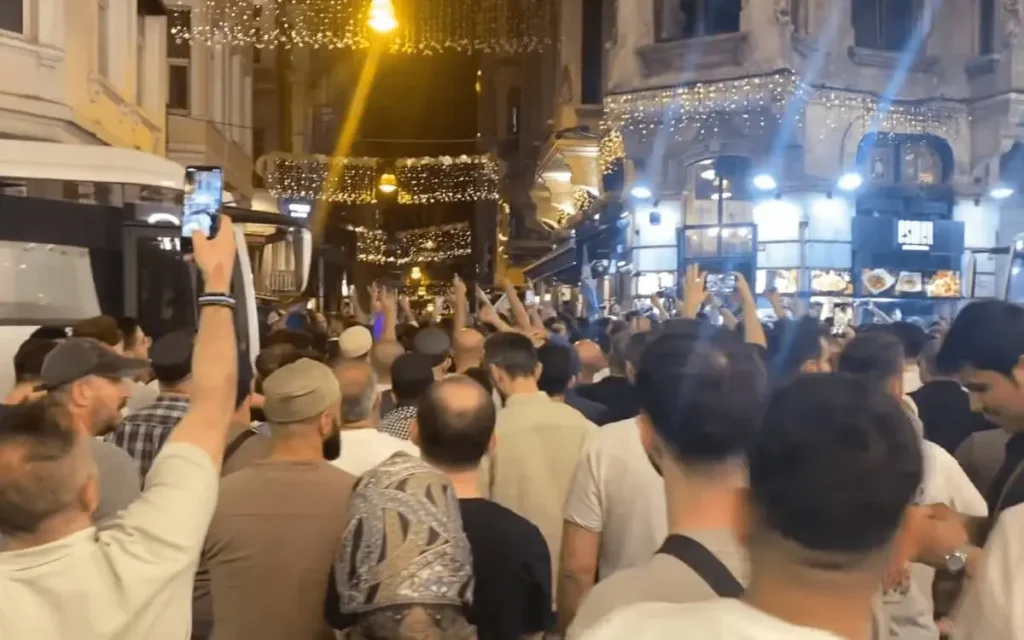On July 2, 2025, significant protests erupted in Istanbul following an assault on the editorial team of the satirical magazine LeMan, which is known for its critical stance against political figures and social issues. This incident comes in the wake of a controversial caricature that some have claimed offends religious sentiments, prompting both a violent attack on the magazine’s offices and arrests of its staff members. Various organizations have expressed their outrage, calling it an egregious attack on press freedom in Turkey, where censorship and harassment of journalists remain prevalent.
| Article Subheadings |
|---|
| 1) Overview of the Incident |
| 2) Details of the Arrests |
| 3) Government and Official Responses |
| 4) Broader Implications on Press Freedom |
| 5) Community Reactions and Ongoing Protests |
Overview of the Incident
The turmoil began on June 26, 2025, when LeMan published a provocative cartoon that depicted religious figures in a contentious manner. This specific cartoon reportedly featured a character greeting another while standing amidst rubble, making a direct reference to the Prophet Muhammad. Following its circulation, the Istanbul prosecutor’s office launched an investigation on June 30, accusing several members of the magazine’s staff of “denigrating religious values.” The publication’s provocative nature and the charged environment around freedom of expression in Turkey contributed significantly to the outburst of violence against the magazine.
Details of the Arrests
On the same day that the investigation was announced, law enforcement stormed LeMan’s offices, leading to the swift arrest of four staff members, which included the cartoonist, Dogan Pehlivan, along with crucial editorial figures such as Zafer Aknar, the editor-in-chief, and Cebrail Okcu, a graphic designer. Moreover, Ali Yavuz, the editorial director, also fell prey to the crackdown. Reports indicate a total of six warrants were issued, with co-founder and previous editor-in-chief Tuncay Akgün and current editor-in-chief Aslan Ozdemir being targeted, although they were located abroad at the time. The media outlet’s website was rendered inaccessible shortly after the arrests, further signaling a crackdown on press freedom.
Government and Official Responses
Following the incident, high-ranking officials, including Fahrettin Altun, the presidential spokesperson, and Interior Minister Ali Yerlikaya, publicly denounced the cartoon, emphasizing the government’s position against what they termed as attacks on religious sentiments. Justice Minister Yilmaz Tunc joined the condemnation, illuminating how critical the government’s stance is on safeguarding religious values. Such public statements have been interpreted by many as an implicit endorsement of the violent actions taken against the magazine, exacerbating fears around state-sanctioned suppression of free speech.
Broader Implications on Press Freedom
Turkey has been grappling with decreasing press freedom, as indicated by its ranking of 159th on the World Press Freedom Index. This latest incident provides further evidence that the country’s journalists often face significant challenges and threats, not only from state institutions but also from societal backlash for their work. The arrest of LeMan’s staff and subsequent violence raise urgent questions about the longevity of independent journalism in Turkey. Erol Önderoglu, a representative of Reporters Without Borders, has strongly criticized the government’s inaction against violence towards journalists, especially noting the irony of police inactivity even as they mobilized heavily against other forms of public assembly previously.
Community Reactions and Ongoing Protests
The assault on LeMan resulted in protests from various civil society groups and individuals advocating for press freedom. Several demonstrations were organized in response, where community members articulated their dissent against governmental restrictions on free expression. Activists underscored the need for an environment where satire and journalism can coexist without fear of violence or incarceration. Following these protests, clashes erupted in other urban areas, often resulting in police intervention with rubber bullets and tear gas, igniting further public outrage regarding governmental repression and the suppression of artistic expression.
| No. | Key Points |
|---|---|
| 1 | The editorial team of LeMan faced violence and arrests following the publication of a controversial caricature. |
| 2 | Four staff members, including the cartoonist, were arrested on charges of denigrating religious values. |
| 3 | Government officials publicly condemned the caricature and justified the police response. |
| 4 | Turkey’s standing on the World Press Freedom Index remains low, indicating broader issues of censorship. |
| 5 | Protests erupted in response to the attacks against LeMan, highlighting ongoing tensions surrounding press freedom. |
Summary
The events surrounding LeMan in Istanbul serve as a stark reminder of the precarious state of press freedom in Turkey. As the world witnesses rising intolerance toward dissenting voices, the swift action against LeMan’s editorial team shines a light on the ongoing challenges faced by journalists and satirists under oppressive regimes. These incidents foster significant dialogue about the need for protective measures for journalists to operate freely and safely, emphasizing the critical role of satire in a functioning democracy.
Frequently Asked Questions
Question: What led to the arrests of LeMan’s editorial team?
The arrests were triggered by the publication of a controversial caricature that was deemed offensive to religious sentiments, prompting authorities to accuse the staff of denigrating religious values.
Question: How has the government responded to the violence against LeMan?
Government officials have publicly condemned the caricature and justified the violent actions against the magazine, indicating a troubling stance against freedom of expression.
Question: What does the incident imply for the future of press freedom in Turkey?
This incident highlights the increasing risks and challenges journalists face in Turkey, raising concerns about the future of independent media and the suppression of dissenting voices in the country.


